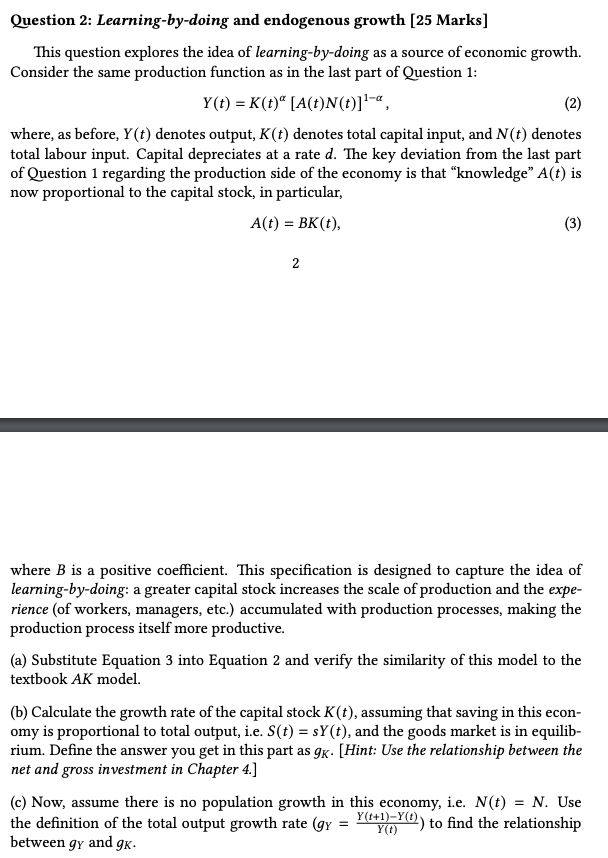Answered step by step
Verified Expert Solution
Question
1 Approved Answer
please answer all Question 2: Learning-by-doing and endogenous growth [25 Marks] This question explores the idea of learning-by-doing as a source of economic growth. Consider

please answer all
Question 2: Learning-by-doing and endogenous growth [25 Marks] This question explores the idea of learning-by-doing as a source of economic growth. Consider the same production function as in the last part of Question 1: Y(t)=K(t)[A(t)N(t)]1, where, as before, Y(t) denotes output, K(t) denotes total capital input, and N(t) denotes total labour input. Capital depreciates at a rate d. The key deviation from the last part of Question 1 regarding the production side of the economy is that "knowledge" A(t) is now proportional to the capital stock, in particular, A(t)=BK(t), where B is a positive coefficient. This specification is designed to capture the idea of learning-by-doing: a greater capital stock increases the scale of production and the experience (of workers, managers, etc.) accumulated with production processes, making the production process itself more productive. (a) Substitute Equation 3 into Equation 2 and verify the similarity of this model to the textbook AK model. (b) Calculate the growth rate of the capital stock K(t), assuming that saving in this economy is proportional to total output, i.e. S(t)=sY(t), and the goods market is in equilibrium. Define the answer you get in this part as gK. [Hint: Use the relationship between the net and gross investment in Chapter 4.] (c) Now, assume there is no population growth in this economy, i.e. N(t)=N. Use the definition of the total output growth rate (gY=Y(t)Y(t+1)Y(t)) to find the relationship between gY and gK. Question 2: Learning-by-doing and endogenous growth [25 Marks] This question explores the idea of learning-by-doing as a source of economic growth. Consider the same production function as in the last part of Question 1: Y(t)=K(t)[A(t)N(t)]1, where, as before, Y(t) denotes output, K(t) denotes total capital input, and N(t) denotes total labour input. Capital depreciates at a rate d. The key deviation from the last part of Question 1 regarding the production side of the economy is that "knowledge" A(t) is now proportional to the capital stock, in particular, A(t)=BK(t), where B is a positive coefficient. This specification is designed to capture the idea of learning-by-doing: a greater capital stock increases the scale of production and the experience (of workers, managers, etc.) accumulated with production processes, making the production process itself more productive. (a) Substitute Equation 3 into Equation 2 and verify the similarity of this model to the textbook AK model. (b) Calculate the growth rate of the capital stock K(t), assuming that saving in this economy is proportional to total output, i.e. S(t)=sY(t), and the goods market is in equilibrium. Define the answer you get in this part as gK. [Hint: Use the relationship between the net and gross investment in Chapter 4.] (c) Now, assume there is no population growth in this economy, i.e. N(t)=N. Use the definition of the total output growth rate (gY=Y(t)Y(t+1)Y(t)) to find the relationship between gY and gKStep by Step Solution
There are 3 Steps involved in it
Step: 1

Get Instant Access to Expert-Tailored Solutions
See step-by-step solutions with expert insights and AI powered tools for academic success
Step: 2

Step: 3

Ace Your Homework with AI
Get the answers you need in no time with our AI-driven, step-by-step assistance
Get Started


